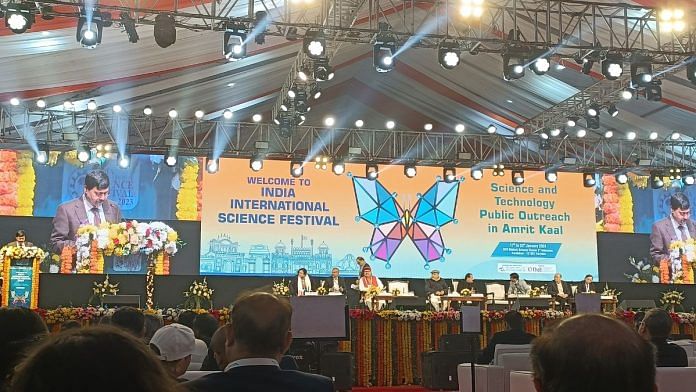New Delhi: At a walk-in exhibit with huge styrofoam models of viruses, test tubes, and agar plates, students watched in fascination as an instructor explained how vaccines were made. They nodded in unison as she cited the example of Covaxin, an indigenously manufactured Covid-19 vaccine. “I got a Covaxin shot! Wow, so this is how they made it?” a 12-year-old boy from Nanded excitedly discussed with his classmates.
The exhibit by the Translational Health Science and Technology Institute was one among hundreds at the India International Science Festival in Haryana’s Faridabad, which paid tribute to the country’s scientific and technological journey.
The ninth iteration of the four-day-long festival, which began on 17 January, was organised by the central government’s science and technology departments. This year’s theme was ‘Science and Technology Public Outreach in Amrit Kaal’. The events, which included a range of exhibits and a student hackathon, were geared toward increasing public understanding of science.
“Science is only impactful if our citizens understand it, use it, and take it forward,” said Moolchand Sharma, the education minister of Haryana, at the inauguration.
From Covid to Chandrayaan
India’s successful moon mission has sparked interest in space exploration, and this was quite evident at the festival. ISRO’s stall was a fan favourite. Their exhibit, showcasing India’s space achievements with a focus on the Chandrayaan-3 and Aditya-L1 missions, drew a throng of curious visitors.
The stall also displayed information on endeavours such as the XPoSat – ISRO’s newly launched satellite that will conduct an X-ray polarimetry study on celestial objects.
“ISRO was born in 1969, the year in which America put a man on the moon. Now, in 2023, ISRO managed to reach the Moon’s south pole, a feat no country, not even America, has yet achieved,” Dr Jitendra Singh, Minister of State for the Ministry of Science and Technology, said at the event.
Like every year, central government departments – like the Department of Biotechnology, the Department of Space, and the Department of Science and Technology – put up their own public displays to highlight the innovations and achievements of Indian scientists.
A particularly interesting section was the new ‘anti-Covid’ drug by the Defence Research and Development Organisation (DRDO), which has been cleared for emergency use in hospitals by the Drug Controller General of India (DCGI). Called 2-Deoxy-D-Glucose, it is an oral powder developed by DRDO’s Institute of Nuclear Medicine and Allied Sciences (INMAS) in collaboration with Dr Reddy’s Laboratories in Hyderabad.
“Our drug attacks virus-infected cells and prevents their growth. If any cell has contracted Covid, our drug will specifically target it and stop its energy production, thus killing it,” said Mahesh, a young researcher at INMAS who worked on the final stages of the drug. “We are now in talks with 13 pharma companies to manufacture and market this anti-Covid medicine.”
Also read: Women must lead climate change fight, they are hit hardest – Dr Soumya Swaminathan
New frontiers in environment-friendly tech
As much as IISF celebrated past achievements of Indian science, it also provided a platform for upcoming technologies.
Students from the Bengaluru-based Jawaharlal Nehru Centre for Advanced Scientific Research displayed a ‘cost-effective’ method to reduce carbon dioxide emissions in the atmosphere. The team, led by their professor Sebastian C Peter, came up with a way to convert carbon dioxide to methanol, which is categorised as a low-carbon fuel. The NITI Aayog calls it the ‘best pathway’ for meeting India’s global carbon emissions reduction targets.
Students from JNCASR showcased a model power plant that converts carbon dioxide into methanol using hydrogen and a special catalyst patented by Peter and his team. Companies like Tata Steel and Coal India Limited, which emit carbon dioxide due to their thermal and steel power plants, hope to utilise this technology, said Peter.
Also read: How do you write a book on India’s climate strategy? By praising PM Modi’s vision
A purple revolution
At one end of the vast exhibition hall was a section dedicated to the Council of Scientific and Industrial Research, which emphasised initiatives such as the ‘steel slag’ roads constructed in Arunachal Pradesh, Gujarat, Maharashtra, and Jharkhand. These roads are made by reusing slag, an industrial waste from steel plants.
CSIR’s Director General Dr N Kalaiselvi also spoke about the ‘purple revolution’ heralded by the organisation. Started under CSIR’s ‘Aroma Mission’, this movement aims to encourage lavender growth in the Jammu region, giving incentive to the home-grown cultivation, processing and marketing of lavender scents, oils, and products.
“The country has benefited from the green revolution and the white revolution, so we thought it’s time to extend it to the agro-tech sector in Jammu with the purple revolution,” Kalaiselvi told The Print.
The aim isn’t just lavender production, though. “It’s to enable local communities to sustain themselves with their indigenous knowledge. We’re taking the spirit of Make in India to the hills.”
(Edited by Zoya Bhatti)



